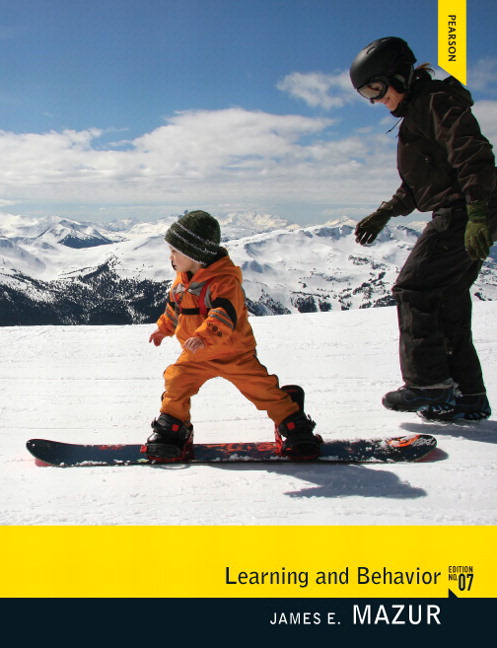Test Bank for Learning & Behavior 7/E 7th Edition James E. Mazur
$35.00 Original price was: $35.00.$26.50Current price is: $26.50.
Test Bank for Learning & Behavior 7/E 7th Edition James E. Mazur
Test Bank for Learning & Behavior 7/E 7th Edition James E. Mazur digital download immediately after payment is complete.

Product details:
- ISBN-10 : 0205246443
- ISBN-13 : 978-0205246441
- Author: James E. Mazur
A thorough survey of the field of learning.
Learning & Behavior covers topics such as classical and operant conditioning, reinforcement schedules, avoidance and punishment, stimulus control, comparative cognition, observational learning, motor skill learning, and choice.The book includes thorough coverage of classic studies and the most recent developments and trends, while providing examples of real-world applications of the principles discovered in laboratory research. It also emphasizes the behavioral approach but not exclusively so; many cognitive theories are covered as well, and there is a chapter on comparative cognition.
Table Of Contents:
Chapter 1 History, Background, and Basic Concepts Chapter 2 Innate Behavior Patterns and Habituation Chapter 3 Basic Principles of Classical Conditioning Chapter 4 Theories and Research on Classical Conditioning Chapter 5 Basic Principles of Operant Conditioning Chapter 6 Reinforcement Schedules: Experimental Analyses and Applications Chapter 7 Avoidance and Punishment Chapter 8 Theories and Research on Operant Conditioning Chapter 9 Stimulus Control and Concept Learning Chapter 10 Comparative Cognition Chapter 11 Learning by Observation Chapter 12 Learning Motor Skills Chapter 13 Choice Glossary References Acknowledgments Author Index Subject Index
2. FULL TABLE OF CONTENTS Preface
Chapter 1: History, Background, and Basic Concepts The Search for General Principles of Learning The Associationists Aristotle The British Associationists: Simple and Complex Ideas Ebbinghaus,s Experiments on Memory The Effects of Repetition The Effects of Time The Role of Contiguity The Influence of the Associationists and Ebbinghaus Behavioral and Cognitive Approaches to Learning The Use of Animal Subjects The Emphasis on External Events The Physiological Approach: Brain and Behavior The Basic Characteristics of Neurons Physiological Research on Simple Sensations Physiological Research on Feature Detectors Physiological Research on Learning Summary Review Questions
Chapter 2: Innate Behavior Patterns and Habituation Characteristics of Goal-Directed Systems Reflexes Tropisms and Orientation Kineses Taxes Sequences of Behavior Fixed Action Patterns Reaction Chains Innate Human Abilities and Predispositions Habituation General Principles of Habituation Physiological Mechanisms of Habituation Habituation in Emotional Responses: The Opponent-Process Theory Summary Review Questions
Chapter 3: Basic Principles of Classical Conditioning Pavlov,s Discovery and Its Impact The Standard Paradigm of Classical Conditioning The Variety of Conditioned Responses Pavlov,s Stimulus Substitution Theory S-S or S-R Connections? Basic Conditioning Phenomena Acquisition Extinction Spontaneous Recovery, Disinhibition, and Rapid Reacquisition Conditioned Inhibition Generalization and Discrimination The Importance of Timing in Classical Conditioning CS-US Correlations Higher Order Conditioning Classical Conditioning Outside the Laboratory Classical Conditioning and Emotional Responses Classical Conditioning and the Immune System Applications in Behavior Therapy Summary Review Questions
Chapter 4: Theories and Research on Classical Conditioning Theories of Associative Learning The Blocking Effect The Rescorla-Wagner Model Other Theories Summary Types of Associations Associations in First-Order Conditioning Associations in Second-Order Conditioning Associations with Contextual Stimuli CS-CS Associations Occasion Setting Summary Biological Constraints on Classical Conditioning The Contiguity Principle and Taste-Aversion Learning Biological Preparedness in Taste-Aversion Learning Biological Preparedness in Human Learning Biological Constraints and the General-Principle Approach The Form of the Conditioned Response Drug Tolerance and Drug Cravings as Conditioned Responses Conditioned Opponent Theories Physiological Research on Classical Conditioning Summary Review Questions
Chapter 5: Basic Principles of Operant Conditioning The Law of Effect Thorndike,s Experiments Guthrie and Horton: Evidence for a Mechanical Strengthening Process Superstitious Behaviors The Procedure of Shaping, or Successive Approximations Shaping Lever Pressing in a Rat Shaping Behaviors in the Classroom Shaping as a Tool in Behavior Modification Making Shaping More Precise: Percentile Schedules Versatility of the Shaping Process The Research of B. F. Skinner The Free Operant The Three-Term Contingency Basic Principles of Operant Conditioning Resurgence Conditioned Reinforcement Response Chains Biological Constraints on Operant Conditioning Instinctive Drift Autoshaping Reconciling Reinforcement Theory and Biological Constraints Summary Review Questions
Chapter 6: Reinforcement Schedules: Experimental Analyses and Applications Plotting Moment-to-Moment Behavior: The Cumulative Recorder The Four Simple Reinforcement Schedules Fixed Ratio Variable Ratio Fixed Interval Variable Interval Extinction and the Four Simple Schedules Other Reinforcement Schedules Factors Affecting Performance on Reinforcement Schedules Behavioral Momentum Contingency-Shaped versus Rule-Governed Behaviors Reinforcement History Summary The Experimental Analysis of Reinforcement Schedules Cause of the FR Postreinforcement Pause Comparisons of VR and VI Response Rates Applications of Operant Conditioning Teaching Language to Children with Autism Token Reinforcement Organizational Behavior Management Behavior Therapy for Marital Problems Conclusions Summary Review Questions
Chapter 7: Avoidance and Punishment Avoidance A Representative Experiment Two-Factor Theory Evidence Supporting Two-Factor Theory Problems with Two-Factor Theory One-Factor Theory Cognitive Theory Biological Constraints in Avoidance Learning Conclusions about the Theories of Avoidance Flooding as Behavior Therapy Learned Helplessness Punishment Is Punishment the Opposite of Reinforcement? Factors Influencing the Effectiveness of Punishment Disadvantages of Using Punishment Negative Punishment Behavior Decelerators in Behavior Therapy Positive Punishment Negative Punishment: Response Cost and Time-Out Other Techniques for Behavior Deceleration Summary Review Questions
Chapter 8: Theories and Research on Operant Conditioning The Role of the Response The Role of the Reinforcer Is Reinforcement Necessary for Operant Conditioning? Expectations about the Reinforcer Can Reinforcement Control Visceral Responses? Biofeedback How Can We Predict What Will Be a Reinforcer? Need Reduction Drive Reduction Trans-situationality Premack,s Principle Response Deprivation Theory The Functional Analysis of Behaviors and Reinforcers Behavioral Economics Optimization: Theory and Research Elasticity and Inelasticity of Demand Behavioral Economics and Drug Abuse Other Applications Summary Review Questions
Chapter 9: Stimulus Control and Concept Learning Generalization Gradients Measuring Generalization Gradients What Causes Generalization Gradients? Is Stimulus Control Absolute or Relational? Transposition and Peak Shift Spence,s Theory of Excitatory and Inhibitory Gradients The Intermediate-Size Problem Other Data, and Some Conclusions Behavioral Contrast “Errorless” Discrimination Learning Transfer of Learning and Learning Sets Concept Learning The Structure of Natural Categories Animal Studies on Natural Concept Learning Developing Stimulus Equivalence Stimulus Control in Behavior Modification Stimulus Equivalence Training Study Habits and Health Habits Insomnia Summary Review Questions
Chapter 10: Comparative Cognition Memory and Rehearsal Short-Term Memory, or Working Memory Rehearsal Long-Term Memory, Retrieval, and Forgetting Time, Number, and Serial Patterns Experiments on an “Internal Clock” Counting Serial Pattern Learning Chunking Language and Reasoning Teaching Language to Animals Reasoning by Animals Summary Review Questions
People also search:
learning and behavior 7th edition
|
learning and behavior paul chance 7th edition pdf free
|
learning and behavior 7th edition ebook











